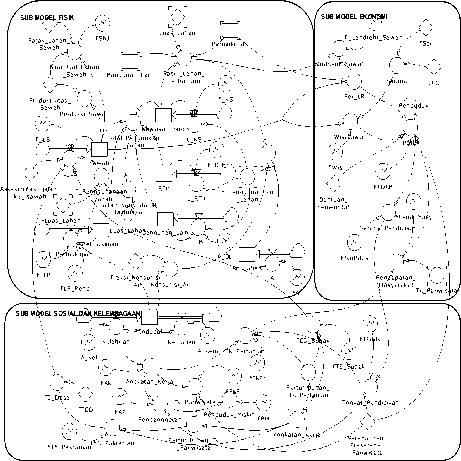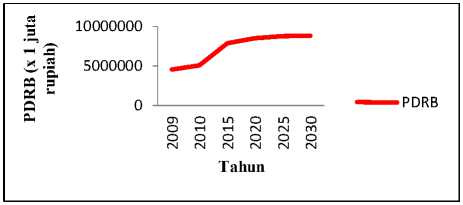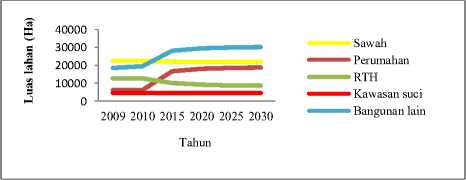Effectiveness of Local Institutions as The Basis of Sustainable Tourism Village
on
E-Journal of Tourism Vol.4. No.1. (2017): 13-18
1Effectiveness of Local Institutions as The Basis of Sustainable Tourism Village
Widhianthini
Bogor Agriculture Institute, Indonesia
Corresponding author: wiwin_purantara@yahoo.com
ARTICLE INFO ABSTRACT
Received
20 October 2016
Accepted 01 March 2017
Available online 31 March 2017
The purpose of this study was to describe the institutional position of local water control system and Pakraman as policy makers in developing sustainable tourism villages. This study was conducted in Tabanan, Bali. Tabanan is a famous tourist village area with rice barns. Analytical approach through a dynamic system combined with the scoring system. The results of the study reinforced the position of local institutions such as Subak and Pakraman that collaborate to determine the sustainability of tourism villages. The local institutions act as policy makers so there is no shifting balance of nature (a decrease in agricultural land or fields). This success will be realized if the role of local institutions were legitimized through local legislation and awig awig so the model of sustainable tourism village could be directed and conserved.
Keywords: local institutions (Subak and Pakraman), tourism villages, dynamical systems, Provincial Regulations of awig awig
Introduction
Background
Law Number 26/2007 regarding Spatial Planning, explained that the purpose of spatial planning, among others, the achievement of the utilization of space qualified for: (1) create the value of human intelligence, virtues and prosperity for nation, (2) create an integrated utilization of resources, (3 ) increase the
utilization of natural resources in an efficient and effective way for human, and (4) realize the function of protection space as well as preventing damage to the environment. This law explains that in order to obtain optimal results in the development of the area required the arrangement of space, which is a process that starts from the preparation of the spatial plan by allocating the spatial plan of natural
1The article had been presented in The International Tourism Conference “Promoting Cultural & Heritage Tourism” at Udayana University, 1-3 September 2016.
and artificial resources optimally through the supervision and control of the development (the use of space) to match with the spatial plan. The role of local or indigenous communities is necessary for spatial management in a region.
Traditional or local community involvement in planning the development of a region or country could be realized if their position were balanced with the government. Visualizing the role of local or indigenous communities in sustainable development originally started on the development of the village. Rural development is the embryo of a region space arrangement.
When viewed from the Bali GRDP contribution at current prices according to the 2010-2014 business field (in percent), the agricultural sector has decreased from time to time. In 2010 the contribution of the agriculture sector reached 18.01 percent while in 2014 decreased to 16.82 per cent (BPS Propinsi Bali, 2014). This is because the
agricultural sector is not only related to the fulfillment of domestic consumption, but also closely related to the condition of Bali tourism. Agriculture is the root of Balinese culture that also became a capital for tourism.
Trades, hotels and restaurants (THR) seem to be appear as a major contributor to the GDP of Bali, although the contribution of this sector tends to fluctuate with growing tourism. In 2009, the contribution of this sector has reached 29.64 percent. This contribution increased in 2013 reached 29.89 percent (BPS Bali Province 2014). This condition is due to the improvement in tourism in Bali characterized by an increasing number of tourist arrivals, hotel occupancy rates and other economic activities.
Tabanan is one of the regencies in Bali which has the largest rice fields (22.453 hectares) with 228 Subak as well as the rice granary in Bali that suffer from under threats over wetland function after Badung regency. The amount of wetland function transfer in 2013 was 204 hectares more than in 2009 that only 97 hectares. This condition occurs because less land in Badung and the increasingly high price of land in the district. The decline in paddy fields is also caused by declining public interest to pursue the agricultural sector apart from the result obtained that less than expected. Their conversion of agricultural land (paddy fields) in Bali had very serious implications for food production, which then exacerbate food security.
The Provincial Government of Bali then make a plan of sustainable development of rural tourism as a measure to overcome the conversion of agricultural land to non-agricultural (Tabanan Regional Development Planning Agency, 2011). Anticipation was taken due to the spatial Bali that increasingly chaotic and the depletion of the space for local people to survive in their own areas.
Research Problem
Development of rural tourism should implement a community-based tourism approache (local communities). In this position the community plays an important role in supporting the development of tourism.
Government and private sector involvement was limited to facilitating the people as the main actors for rural tourism development. In accordance with the essence of rural tourism should be initiated locally and independently by local communities. This means that the government only as a facilitator. The process of growth and development of tourist villages will depend on the community itself. Community involvement can be realized in the form of provision of accommodation facilities such as homes (home stay), supplying the needs of the consumption of tourists, tour guide, local transport provision, performing arts, and others.
Approach to the development of ecotourism should manage their resources in order to maintain their original condition as far as possible and to abstain from traveling in sensitive areas that are easily damaged and difficult to rehabilitate (Thavarasukha, 2009). His research reflects that ecotourism should promote the development of education and creation of awareness for maintaining regional ecosystems not only exploit the economic growth. Ecotourism management should involve local communities in the development process, especially in the transfer of culture. This should include their participation in formulating development plans.
In Japan, ecotourism is not limited only to nature, but also includes travel that focuses on local lifestyles, learning about the culture and history of the place, and to support local-based industries (Shikida et al., 2010). The ecotourism concept is often interpreted as a tool for the development of local communities that utilize a variety of local resources. A broader view of ecotourism will also consider environmental education and cultural exchange between urban and rural communities can be a part of ecotourism. Local communities still have autonomy in planning but still monitored by the Japanese government. Program development of sustainable tourism villages in various countries have in common with the system implemented in Bali. Local communities through local institutions such as Subak and Pakraman granted autonomy in organizing and managing the area as one of the objects of the tourists attraction.
Research Objective
Objective of the research is to develop a sustainable model of rural tourism by incorporating elements of institutional effectiveness of Subak and Pakraman especially in Tabanan, Bali so that the sustainable tourism area can be realized.
Methodology
The location of this research is Tabanan, Bali. Sample for local institution effectiveness is Jatiluwih village which is a World Cultural Heritage. Location was chosen by the fact that this district has 70 percent of rural areas and extensive rice so that Bali government declared the area as a tourism village, but on the other hand experienced a wetland conversion of 741 hectares over the past five years. Samples are Subak and Pakraman board, each member of the local institutions, village officer in Jatuluwih (64 samples). Collection of secondary data in Tabanan involving physical aspects (especially the use of land, water discharge), economy (particularly the Gross Regional Domestic Product (GDP), public revenues, and other aspects and social (population, labor force in agriculture and tourism, and other aspects). In this study, the discussion focused on the physical aspects such as land and economic aspects such as the GDP.
Local institution effectiveness is analyzed using a score. If the score is bigger, it can be said that the local institutions (Pakraman, Subak) are effective and vice versa, the smaller the resulting score the more ineffective the local institutions are. Scores calculated as follows (Norken 2003):
(Mi + 2 Sdi) < x < (Mi + 3 Sdi) : Very Effective
(Mi + 1 Sdi) < x < (Mi + 2 Sdi ) : Effective (Mi - 1 Sdi) < x < (Mi + 1 Sdi) : Quite Effective
(Mi - 2 Sdi) < x < (Mi - 1 Sdi) : Ineffective
(Mi - 3 Sdi) < x < (Mi - 2 Sdi) : Very
Ineffective wherein :
Mi=Mean ideal = (1/2 x (ideal maximum score + ideal minimum score))
Sdi = Standard Deviation ideal = (1/6 x (ideal maximum score – ideal minimum score)
Institutional considered effective if it has the purpose to be achieved, appropriate means and ability, so that the desired goals can be achieved with excellent results (Paraso, 2013). Pakraman and Subak will not be effective by itself. Both institutions require the assistance of local authorities. Widhianthini (2006), Mudhina (2009), and Nunuk (2010) explained that the local institution effectiveness can be seen from the aspect of: institutional, human resources performance, management, and financing. The total yield of local institution effectiveness for Subak, Pakraman, incorporated in the simulation of dynamic systems. In this study conducted a simulation for 21 years (from 2009-2030).
Dynamic system is a representation of the behavior of a system which has an interdependent relationship and changes with time. It can be said that dynamic system feedback (feedback structure) is interrelated and heading towards equilibrium. In this stage, previously determined factors that affecting and affected by the results of the survey (Sterman, 2000). In this study, the effectiveness will be associated with physical systems, economic systems, social systems and institutions using Powersim Studio 10 software.
Results and Discussion
Barlowe (1978) also explains that the demand for land is generally affected by two types of demand, direct demand and derived demand. Direct demand has meant that the land serves for consumption or housing. Direct demand can definitely give benefits. In derived demand, the increased population growth will lead to a high demand for land as a place to produce goods and services or economic activities. Increased demand for land will continueand limited the land availability. This condition is said to be a land use or land conversion. The case of land conversion that occurs in Tabanan started peaking since the district launched tourism as a sector in the region.
Local institution system affecting the model of sustainable tourism village. The level of effectiveness in the Jatiluwih Subak is 82.66 percent. The effectiveness of Pakraman in the village is 90.36 percent, while the level
of effectiveness of official village was 83.3 percent.

Figure 1. Model of local-based sustainable tourism village
The simulation results showed that only 3.21 per cent decline in the paddy field for 21 years. The decline in the sacred area at the end of 2030 is quite low, which is 1.26 per cent of institutional elements of Desa Jatiluwih.
Table 1 Simulation of Land Use in Tabanan regency, with the Local institution Elements (Ha)
The shrine is the area around the temple that should be kept its purity status as defined in Pura Parisadha Bhisama Holiness Hindu Dharma Indonesia Center (PHDIP) 1994. The shrine area is also a protected area by the local government.
Tabanan Bali society maintain the sanctity and preservation of the sacred area so the possibility of decreasing is low. The loss of sacred area normally beacause of the expansion of rural infrastructure, such as roads, community halls, or Subak halls.
Different cases will be seen if the local institution elements (Subak and Pakraman) were not involved in sustainable tourism villages, there will be a decrease in wetland that is higher than the previous case. In Table 2 shows that the decline in land by 15 percent in 21 years. These conditions will be experienced also in sacred area, where changes in sacred area were 7.05 percent.
Table 2. Simulation of Land Use in Tabanan, Without Local institution Elements (Ha)
|
Year |
Paddy Field |
Housing |
Green space |
Sacred Area |
Other buildings |
|
2009 |
22,465 |
6,047 |
12,582. |
4,603 |
18,440 |
|
2010 |
21,149 |
6,404 |
11,855 |
4,332 |
20,452 |
|
2015 |
19,659 |
18,525 |
9,067 |
4,069 |
30,066 |
|
2020 |
19,343 |
20,149 |
8,055 |
4,030 |
31,547 |
|
2025 |
19,192 |
20,791 |
7,725 |
4,008 |
32,064 |
|
2030 |
19,074 |
21,051 |
7,604 |
3,986 |
32,214 |
Source: Data Analysis (2014)
|
Year |
Paddy Field |
Housing |
Green space |
Sacred Area |
Other buildings |
|
2009 |
22,465. |
6,047. |
12,582. |
4,603. |
18,440 |
|
2010 |
22,456. |
6,052. |
12,584. |
4,599 |
19,331 |
|
2015 |
22,045. |
16,717 |
10,167. |
4,563 |
28,146 |
|
2020 |
21,836. |
18,084 |
9,094 |
4,550 |
29,533 |
|
2025 |
21,765 |
18,593 |
8,761 |
4,546 |
30,017 |
|
2030 |
21,744. |
18,748 |
8,668 |
4,544 |
30,157 |
Source: Data Analysis (2014)
|
'e? 35000 | |
|
30000 |
Sawah |
|
g 25000 |
^^^^^^" Perumahan |
|
20000 = 15000 |
RTH ^^^^^^m Kawasan suci |
|
10000 | |
|
5000 | |
|
0 |
— |
|
2009 2010 2015 2020 2025 2030 | |
|
Tahun |
the increase in people's income from time to time in line with the development of tourism villages.

Figure 4 Graph simulation results GRDP in Tabanan by incorporating elements of local institutions
Based on simulation results proved that a model of sustainable tourism villages implementing institutional involvement of local Subak and Pakraman as policy makers (as a subject). Sustainable tourism is tourism with local institutions such as Subak and Pakraman have their position as a basis for the development of a region with Tri Hita Karana as its fundamental philoshophy.
Conclusion
Local institutions especially Subak and Pakraman still exist today with the norms of Tri Hita Karana as a social institution to regulate their relationship with natural resources. Both became legitimate power on the management of sustainable tourism village (next to water resource management at the community level).
Model of sustainable tourism is tourism models that incorporate elements of local institutions Subak and Pakraman as policy makers directly in each step of the development of the region. By incorporating elements of the local institution, agricultural land can still survive and the natural balance is maintained.
Recommendations
Strengthening the role of local institutions Pakraman and Subak as a planner of sustainable tourism policies need to be implemented in the Regional Regulation and awig awig so that the position of the local
institutions legitimacy will be recognized. With strengthening this legitimacy in a regional regulation and awig awig, transactions of agricultural land as an asset for tourism can be sustained, considering the Tabanan that is known by its rice barns nickname.
References
(BPS) Badan Pusat Statistik Propinsi Bali (2014) Bali dalam Angka 2013. Denpasar: BPS.
Barlowe, R. (1978) Land Resource Economic. Michigan State University,: Printice.
Mudhina (2009) Strategi Pemberdayaan Subak Di Daerah Pengaliran Sungai (DPS) Tukad Unda. Udayana University.
Nunuk (2010) Partisipasi Subak Dalam Operasi dan Pemeliharaan Jaringan Irigasi Pada Daerah Irigasi Mambal Di kabupaten Badung. Udayana
University.
Paraso, A. (2013) Efektivitas Badan Permusyawaratan Desa Dalam Penyelenggaraan Pengawasan
Pemerintahan Di Desa Sereh (Suatu Studi Di Desa Sereh Kecamatan Lirung Kabupaten Kepulauan Talaud. Available at:
https://ejournal.unsrat.ac.id/index.php/ jurnaleksekutif/article/view/2693. (Accessed: 13 February 2014).
Shikida, A., Yoda, M., Kino, A. and Morishige, M. (2010) ‘Tourism relationship model and intermediary for sustainable tourism management: Case study of the Kiritappu Wetland Trust in Hamanaka, Hokkaido’, Tourism and Hospitality Research. SAGE Publications, 10(2), pp. 105– 115.
Sterman, J. (2000) Business Dynamics: System Thinking and Modeling For a
Complex World. Singapore: The
McGraw Hill Companies.

Figure 2 Graph Simulation of Land Use in Tabanan
Figure 3 Graph Simulation of Land Use in Tabanan Without Inserting Local institution Elements
The results of the simulation model of the economic subsystem to the GDP showed an increase by incorporating elements of local institutions. The value of GDP in 2013 around Rp 6.5 trillion. If seen from the simulation results, the value of GDP the Tabanan in 2030 is Rp 8.8 trillion. Those results were caused by
Thavarasukha, V. (2009) ‘Ecotourism Case Studies in Thailand. Chapter TwentySeven’, in. Thailand.
Widhianthini (2006) Pembangunan Daerah dengan Pendekatan Perencanaan Partisipatif (Revisi). Rural
Development Pioner Project (Propinsi Bali), Kerjasama antara Consulting Service for Small Scale Irrigation Management Project (III) dengan Jurusan Sosial Ekonomi Pertanian Fakultas Pertanian Universitas Udayana.
http://ojs.unud.ac.id/index.php/eot
18
e-ISSN: 2407-392X. p-ISSN: 2541-0857
Discussion and feedback